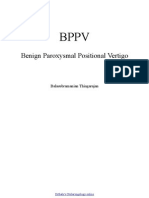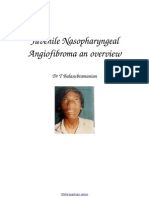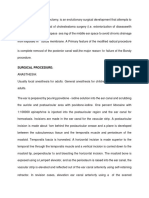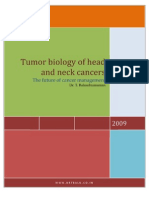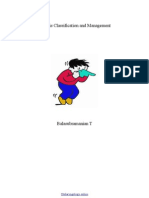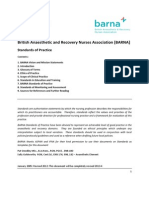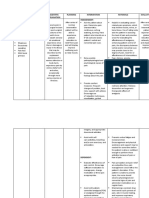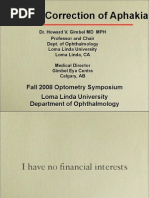Paraph Imaging
Uploaded by
Dr. T. BalasubramanianParaph Imaging
Uploaded by
Dr. T. BalasubramanianRole of imaging in the diagnosis of
parapharyngeal space and adjacent space
lesions
Dr T Balasubramanian
Drtbalu's otolaryngology online
Introduction:
Parapharyngeal space is a suprahyoid neck space. It is surrounded by other important
facial spaces. Old text books divided this space into prestyloid and post stymoid
compartments. The prestyloid compartment lying infront of the styloid process and
the post styloid one lying behind it. Current literature designates post styloid
compartment as carotid space and the prestyloid compartment is considered to be the
true parapharyngeal space. The parapharyngeal space contains fat. This is clearly
visible in imaging and displacement of fat indirectly helps the radiologist to identify
and quantify the extent of lesions involving parapharyngeal space. Parapharyngeal
space is a hidden area that cannot be easily examined. Lesions of this space present
rather late and in advanced stage. A surgeon will have to resort to imaging in order to
visualize this area.
Anatomy:
Anatomically parapharyngeal space could be considered as a cone shaped space
extending from the skull base above and hyoid bone below on either side of pharynx.
Drtbalu's otolaryngology online
Anatomically the carotid space (poststyloid space) is separated from the
parapharyngeal space proper (prestyloid space) by the tensor-vascular-styloid fascia
which overlies the tensor veli palatini muscle. Benign tumors involving this space is
likely to remain confined to the space.
Boundaries of parapharyngeal space:
Superior:
Portion of the temporal bone lateral to the attachment of pharyngobasilar fascia and
medial to the foramen ovale and foramen spinosum. None of the foramina of the
skull base are involved in the formation of superior boundary of parapharyngeal
space.
Inferior:
Greater cornu of hyoid bone
Posterior belly of digastric muscle
At this level the parapharyngeal space blends with the posterior part of
submandibular space
Medial:
Buccopharyngeal fascia
Pharyngobasilar fascia
Pharyngeal constrictors
Lateral:
Fascia covering the pterygoid muscles and sphenomandibular ligament.
Parotid space communicates with parapharyngeal space laterally through the
stylomandibular tunnel. The stylomandibular tunnel is surrounded / enclosed by the
stylomandibular ligament. The stylomandibular ligament extends from the styloid
process to the angle of the mandible.
Anterior:
The pterygomandibular raphe. This raphe extends from the hamulus of the medial
pterygoid plate to the posterior aspect of the mylohyoid line on the lingual surface of
the mandible
Drtbalu's otolaryngology online
Posterior:
The tensor vascular styloid fascia which overlies the tensor veli palatini muscle. This
fascia extends from the medial pterygoid plate to the styloid process.
The anatomical location of the parapharyngeal space is rather unique. It is located
centrally in relation to the surrounding neck spaces. The fat content of this space
gives a unique appearance on CT / MRI. Primary lesions involving the
parapharyngeal space is very rare but the displacement pattern of the fat in this space
due to lesions involving other neck spaces could be an excellent indicator for the
origin of the lesion.
Diagramatic representation of parapharyngeal space and its relations
Drtbalu's otolaryngology online
Axial T1 weighted MR image showing normal radiological anatomy of
parapharyngeal space.
Asterix – Fat plane
PMS – Pharyngeal mucosal space
MS – Masticator space
PS – Parotid space
ICA – Internal carotid artery
IJV – Internal jugular vein
Drtbalu's otolaryngology online
Illustration showing tumor involving the pharyngeal mucosal space displacing the
parapharyngeal space pad of fat inferiorly. This displacement can be clearly seen in
CT / MRI imaging.
Drtbalu's otolaryngology online
Axial CT contrast showing pharyngeal mass pushing the parapharyngeal space
postero laterally with obliteration of the normal fat plane seen in the parapharyngeal
space.
Drtbalu's otolaryngology online
Diagram showing
tumors/lesions of
masseteric space causing
compression of the
parapharyngeal space
pushing in posteromedially.
Drtbalu's otolaryngology online
CT scan axial cut showing masseteric mass pushing the parapharyngeal space
posteromedially
Figure showing parotid tumor growing inwards and pushes the parapharyngeal space
anteromedially. It usually displaces the tonsil / lateral pharyngeal wall medially.
Drtbalu's otolaryngology online
Parotid mass seen pushing the parapharyngeal space medially. Note the pad of fat is
also obliterated. This is a contrast axial CT showing the great vessels (2,3).
Diagram showing carotid space tumor pushing the parapharyngeal space
anterolaterally.
Drtbalu's otolaryngology online
Axial contrast CT showing enhancing mass involving the carotid space pushing the
parapharyngeal space anteromedially. Note the obliteration of fat plane.
Pharyngeal mucosal space:
This space include the nasopharyngeal and oropharyngeal mucosal lining. This space
is lined on the outside by the pharyngeal constrictors and lined on the inside by
squamous epithelium. This space contains minor salivary glands and lymphoid tissue
of the waldayer's ring.
Pharyngeal mucosal space lesions include:
1. Squamous cell carcinoma
2. Tumors involving minor salivary glands
3. Lymphoma
4. Sarcoma
Masticator space:
This space extends from the skull base to the inferior border of the mandible. This
space is enclosed between the split layers of the superficial layer of the deep cervical
fascia.
Contents of this space include:
Drtbalu's otolaryngology online
1. Ascending ramus of mandible
2. Posterior body of mandible
3. Muscles of mastication (masseter, medial and lateral pterygoids and
temporalis)
4. Motor and sensory branches of mandibular division of trigeminal nerve
5. Inferior alveolar artery and vein
The Masseteric space extends superolaterally along the lateral surface of the
temporalis muscle. This portion of the masseteric space is divided into superior and
inferior portions by the presence of zygoma. Anteriorly this space continues with
that of the buccal space. There is ofcourse no facial boundary between these two
spaces and infections can freely traverse between these spaces. The parapharyngeal
space is located postero medial to the masseteric space, hence lesions involving this
space tends to displace the parapharyngeal pad of fat posteromedially.
Drtbalu's otolaryngology online
Axial CT neck showing masseteric abscess (1) pushing the parapharyngeal pad of fat
posteromedially (**)
Malignant tumors involving the mucosal lining of adjoining spaces (oral cavity,
oropharynx and maxillary sinus) frequently invade this space causing trismus due to
involvement of muscles of mastication. This is true for all malignant lesions except
lymphoma. Lymphoma doesn't cause trismus even when masseter muscle is
infiltrated by the tumor cells. Imaging can also help to pinpoint involvement of this
space even before development of trismus. Trismus is infact a late stage of malignant
infiltration of this space. Involvement of this space by malignant tumors puts
mandibular division of trigeminal nerve at risk. Adenocystic carcinoma involving
this space may spread along this nerve. Imaging doesn't clearly reveal perineural
spread of tumors involving mandibular division of trigeminal nerve. Indirect signs of
nerve involvement like thickening of the nerve / enlargement of foramen ovale can be
sought. Enlargement of foramen ovale can be seen only in the bone window cuts of
CT scan. Primary tumors involving this space is rather rare. But tumors involving
this space in paediatric age group should prompt a diagnosis of rhabdomyosarcoma
unless proved otherwise.
Drtbalu's otolaryngology online
Axial CT showing foramen ovale (green arrow) and foramen rotundum (red arrow)
Axial CT (Bone window) showing normal and enlarged foramen ovale
Drtbalu's otolaryngology online
Axial CT scan showing soft tissue mass in the masseteric space.
(Rhabdomyosarcoma)
Common lesions involving the masseteric space:
Inflammatory / infective lesions – odontogenic infections, cellulitis, abscess and
myositis
Congenital – Hemangioma, lymphoid malformation.
Neoplastic – Benign tumors involving muscle / bone
Malignant tumors – Rhabdomyosarcoma, osteosarcoma, osteosarcoma, metastatic
tumors.
Parotid space:
This space lies posterolateral to parapharyngeal space. In this space the superficial
layer of deep cervical fascia splits to enclose this space. The most important content
of this space is the parotid gland. The facial nerve divides the gland into superficial
and deep lobes. The parotid gland becomes encapsulated very late in its development
and this is the reason for the presence of intraparotid lymph nodes.
Most common lesions involving this space are lesions involving the superficial lobe
of parotid gland. Deep lobe of the parotid gland are involved very rarely. The
position of the facial nerve in the parotid gland can be studied by looking for the
retromandibular vein in the CT image of parotid gland. The facial nerve lies lateral to
this vein.
Drtbalu's otolaryngology online
Contrast Axial CT showing malignant tumor involving the right masseteric space.
Axial CT showing mass involving the superficial lobe of parotid gland
Drtbalu's otolaryngology online
Axial CT scan showing mass involving the deep lobe of parotid gland
Common lesions involving the deep lobe of parotid gland are mostly benign.
Pleomorphic adenoma is the commonest. Tumors involving the deep lobe of parotid
gland displaces the parapharyngeal space postero medially. Pleomorphic adenomas
involving the parotid gland lights up bright in T2 weighted MRI images. The
intensity of these lesions in T2 weighted images matches that of CSF fluid. This is
the reason why MRI is the preferred imaging modality in ruling out recurrent tumors
after successful excision of pleomorphic adenomas involving parotid gland. Other
tumors that light up bright in T2 weighted MRI are lymphangioma, hemangioma and
mucoepidermoid carcinomas.
Lesions involving the parotid space include:
Neoplasms:
Pleomorphic adenoma
Warthin tumor
Lipoma
Mucoepidermoid carcinoma
Adenoid cystic carcinoma
Squamous cell carcinoma
Hodgkin's lymphoma
Drtbalu's otolaryngology online
Inflammatory lesions:
Parotitis / abscess
Reactive lymphadenopathy
Lymphoepithelial cysts
Congenital:
Hemangioma
Venous malformation
Lymphatic malformation
Cysts involving first branchial cleft
Carotid space:
This contains the carotid sheath. All three layers of deep cervical fascia contributes
to its formation. This space spans the entire neck from the skull base to the arch of
the aorta. The carotid space lies posterior to the parapharyngeal space.
Contents of this space include:
Carotid artery
Internal jugular vein
Cranial nerves 9,10,11 and 12. The vagus nerve lies posterior and lateral to the
carotid artery.
Sympathetic chain lies posterior and lateral to the carotid artery.
The precise anatomical relationships of the structures of carotid sheath really helps in
discerning the precise anatomical origin of lesion in the carotid sheath. Vascular and
neurogenic tumors are the most common lesions involving this space. Normal
variations involving the internal jugular vein (dominant) or tortuous internal carotid
artery can be mistaken for lesions if contiguous imaging sections involving this area
has not been examined.
Tumors involving the suprahyoid portion of carotid sheath pushes the parapharyngeal
pad of fat anteriorly, the internal carotid artery gets displaced anteriorly and the
internal jugular vein gets displaced laterally.
Most common benign soft tissue tumors involving this space are paragangliomas and
nerve sheath tumors. These tumors are usually asymtomatic and are incidental
discoveries during imaging made for unrelated problems. Imaging helps in discering
Drtbalu's otolaryngology online
paragangliomas from nerve sheath tumors. Paragangliomas are very vascular tumors
and are known to arise:
1. At the bifurcation of common carotid artery (carotid body tumors)
2. At the perineurium of vagus nerve (glomus vagale)
3. From the jugular bulb (glomus jugulare)
4. In the middle ear cavity (glomus jugulare)
Among these four lesions only glomus jugulare and glomus vagale are intimately
related to the parapharyngeal space. These lesions enhance on contrast CT / MRI and
also demonstrate flow voids. Flow voids in MRI are virtually diagnostic of
paraganglioma but it would be apparant only if the tumor is more than 2 cm in
diameter.
Classically carotid body tumor is located at the bifurcation of the carotid artery in the
infrahyoid portion of neck. It splays the internal and external carotid arteries. This
can be clearly visualised in contrast imaging modalities.
Common lesions involving carotid space include:
Neoplastic:
Paraganglioma
Schwannoma
Meningioma
Direct extension of cervical node metastasis
Vascular:
Internal jugular vein thrombosis
Carotid artery thrombosis
Carotid artery aneurysm, pseudoaneurysm
Inflammatory:
Abscesses
Radiological distinction between schwannomas and neurofibromas:
This is not easy. Heterogenous lesions commonly present in schwannomas. This is
due to cystic change / haemorrhage which are commonly seen in schwannomas.
Schwannomas are well encapsulated tumors arising from the schwann cells of the
peripheral nerve sheath. The vagus nerve and the sympathetic chain are the common
sites of origin. Schwannomas don't demonstrate flow voids in MRI even when the
lesions are large. Schwannomas when present close to the skull base can cause
regressive remodelling of bone, this type of remodelling is not seen in
Drtbalu's otolaryngology online
paragangliomas.
Axial contrast CT neck showing carotid body tumor.
Spread of malignant secondary deposits from cervical nodes to the carotid sheath is
common. Infiltration of the carotid artery by the tumor means unresectability. This
can be studied by contrast imaging which clearly demonstrates invasion of the carotid
arterial wall by the tumor.
Drtbalu's otolaryngology online
You might also like
- The Development of The Middle Ear Spaces and Their Surgical Significance100% (2)The Development of The Middle Ear Spaces and Their Surgical Significance15 pages
- Clinical Examination Techniques in Otology Edition II100% (3)Clinical Examination Techniques in Otology Edition II43 pages
- Cleft Lip and Palate Management: A Comprehensive AtlasFrom EverandCleft Lip and Palate Management: A Comprehensive AtlasRicardo D. BennunNo ratings yet
- Postlaryngectomy voice rehabilitation with voice prosthesesFrom EverandPostlaryngectomy voice rehabilitation with voice prosthesesNo ratings yet
- Open Monograph Press Installation To Functioning100% (1)Open Monograph Press Installation To Functioning40 pages
- MGR Medical University MS ENT Basic Sciences March 2009 Question Paper With Solution100% (4)MGR Medical University MS ENT Basic Sciences March 2009 Question Paper With Solution44 pages
- Tamilnadu DR MGR Medical University MS ENT Basic Sciences March 2010 Question Paper With SolutionNo ratings yetTamilnadu DR MGR Medical University MS ENT Basic Sciences March 2010 Question Paper With Solution38 pages
- MS ENT Basic Sciences MGR University September 2009 Question Paper With Solution67% (3)MS ENT Basic Sciences MGR University September 2009 Question Paper With Solution36 pages
- Cholesteatoma Part 9 - Reconstruction of The Mastoid Cavity PDFNo ratings yetCholesteatoma Part 9 - Reconstruction of The Mastoid Cavity PDF4 pages
- Endoscopic Dacryocystorhinostomy - DCR - Surgical TechniqueNo ratings yetEndoscopic Dacryocystorhinostomy - DCR - Surgical Technique11 pages
- Complications of Com: Dr. Ajay Manickam Junior Resident, Dept of Ent RG Kar Medical College100% (1)Complications of Com: Dr. Ajay Manickam Junior Resident, Dept of Ent RG Kar Medical College88 pages
- March - 2010 Tamilnadu DR MGR Medical University Prefinal Otolaryngology Question Paper With SolutionNo ratings yetMarch - 2010 Tamilnadu DR MGR Medical University Prefinal Otolaryngology Question Paper With Solution34 pages
- Ear, Nose and Throat emerg-ENT-cies: With Laura WilkinsNo ratings yetEar, Nose and Throat emerg-ENT-cies: With Laura Wilkins43 pages
- Velopharyngeal Insufficiency and Its Management: DR T Balasubramanian100% (2)Velopharyngeal Insufficiency and Its Management: DR T Balasubramanian15 pages
- Cholesteatoma, A Simple Guide To The Condition, Diagnosis, Treatment And Related ConditionsFrom EverandCholesteatoma, A Simple Guide To The Condition, Diagnosis, Treatment And Related ConditionsNo ratings yet
- Use of Coblation Technology in OtolaryngologyNo ratings yetUse of Coblation Technology in Otolaryngology70 pages
- Eprints From Below Upwards The Manual That Was Missed100% (1)Eprints From Below Upwards The Manual That Was Missed58 pages
- Otolaryngology Online Journal Faciomaxillary Trauma An UpdateNo ratings yetOtolaryngology Online Journal Faciomaxillary Trauma An Update66 pages
- Otolaryngology Online Journal Faciomaxillary Trauma An UpdateNo ratings yetOtolaryngology Online Journal Faciomaxillary Trauma An Update66 pages
- Clinical Examination Techniques in Otology100% (2)Clinical Examination Techniques in Otology44 pages
- Assessment Nursing Diagnosis Scientific Explanation Planning Intervention Rationale Evaluation IndeoendentNo ratings yetAssessment Nursing Diagnosis Scientific Explanation Planning Intervention Rationale Evaluation Indeoendent3 pages
- General Bulletin 153-2020 - School Medical Form100% (1)General Bulletin 153-2020 - School Medical Form5 pages
- Cardiomyopathy: Restrictive Heart DiseaseNo ratings yetCardiomyopathy: Restrictive Heart Disease18 pages
- London Cancer Skin Radiotherapy Guidelines 2013 v1 0No ratings yetLondon Cancer Skin Radiotherapy Guidelines 2013 v1 013 pages
- Guder Et Al Recommendations of The Working Group On Preanalytical Quality of The German Society For Clinical Chemistry and Lab Medecine English100% (1)Guder Et Al Recommendations of The Working Group On Preanalytical Quality of The German Society For Clinical Chemistry and Lab Medecine English41 pages
- Prevention of DVT/PE: Noornadia BT Yahaya 050100841No ratings yetPrevention of DVT/PE: Noornadia BT Yahaya 05010084132 pages
- Approach To Polyarthritis For The Primary Care Physician: Arielle Freilich, DO, PGY2 & Helaine Larsen, DONo ratings yetApproach To Polyarthritis For The Primary Care Physician: Arielle Freilich, DO, PGY2 & Helaine Larsen, DO8 pages
- BCCA AB in Febrile Neutropenia GuidelinesNo ratings yetBCCA AB in Febrile Neutropenia Guidelines2 pages
- The Development of The Middle Ear Spaces and Their Surgical SignificanceThe Development of The Middle Ear Spaces and Their Surgical Significance
- Clinical Examination Techniques in Otology Edition IIClinical Examination Techniques in Otology Edition II
- Cleft Lip and Palate Management: A Comprehensive AtlasFrom EverandCleft Lip and Palate Management: A Comprehensive Atlas
- Postlaryngectomy voice rehabilitation with voice prosthesesFrom EverandPostlaryngectomy voice rehabilitation with voice prostheses
- MGR Medical University MS ENT Basic Sciences March 2009 Question Paper With SolutionMGR Medical University MS ENT Basic Sciences March 2009 Question Paper With Solution
- Tamilnadu DR MGR Medical University MS ENT Basic Sciences March 2010 Question Paper With SolutionTamilnadu DR MGR Medical University MS ENT Basic Sciences March 2010 Question Paper With Solution
- MS ENT Basic Sciences MGR University September 2009 Question Paper With SolutionMS ENT Basic Sciences MGR University September 2009 Question Paper With Solution
- Cholesteatoma Part 9 - Reconstruction of The Mastoid Cavity PDFCholesteatoma Part 9 - Reconstruction of The Mastoid Cavity PDF
- Endoscopic Dacryocystorhinostomy - DCR - Surgical TechniqueEndoscopic Dacryocystorhinostomy - DCR - Surgical Technique
- Complications of Com: Dr. Ajay Manickam Junior Resident, Dept of Ent RG Kar Medical CollegeComplications of Com: Dr. Ajay Manickam Junior Resident, Dept of Ent RG Kar Medical College
- March - 2010 Tamilnadu DR MGR Medical University Prefinal Otolaryngology Question Paper With SolutionMarch - 2010 Tamilnadu DR MGR Medical University Prefinal Otolaryngology Question Paper With Solution
- Ear, Nose and Throat emerg-ENT-cies: With Laura WilkinsEar, Nose and Throat emerg-ENT-cies: With Laura Wilkins
- Velopharyngeal Insufficiency and Its Management: DR T BalasubramanianVelopharyngeal Insufficiency and Its Management: DR T Balasubramanian
- Cholesteatoma, A Simple Guide To The Condition, Diagnosis, Treatment And Related ConditionsFrom EverandCholesteatoma, A Simple Guide To The Condition, Diagnosis, Treatment And Related Conditions
- Eprints From Below Upwards The Manual That Was MissedEprints From Below Upwards The Manual That Was Missed
- Otolaryngology Online Journal Faciomaxillary Trauma An UpdateOtolaryngology Online Journal Faciomaxillary Trauma An Update
- Otolaryngology Online Journal Faciomaxillary Trauma An UpdateOtolaryngology Online Journal Faciomaxillary Trauma An Update
- Assessment Nursing Diagnosis Scientific Explanation Planning Intervention Rationale Evaluation IndeoendentAssessment Nursing Diagnosis Scientific Explanation Planning Intervention Rationale Evaluation Indeoendent
- London Cancer Skin Radiotherapy Guidelines 2013 v1 0London Cancer Skin Radiotherapy Guidelines 2013 v1 0
- Guder Et Al Recommendations of The Working Group On Preanalytical Quality of The German Society For Clinical Chemistry and Lab Medecine EnglishGuder Et Al Recommendations of The Working Group On Preanalytical Quality of The German Society For Clinical Chemistry and Lab Medecine English
- Prevention of DVT/PE: Noornadia BT Yahaya 050100841Prevention of DVT/PE: Noornadia BT Yahaya 050100841
- Approach To Polyarthritis For The Primary Care Physician: Arielle Freilich, DO, PGY2 & Helaine Larsen, DOApproach To Polyarthritis For The Primary Care Physician: Arielle Freilich, DO, PGY2 & Helaine Larsen, DO








